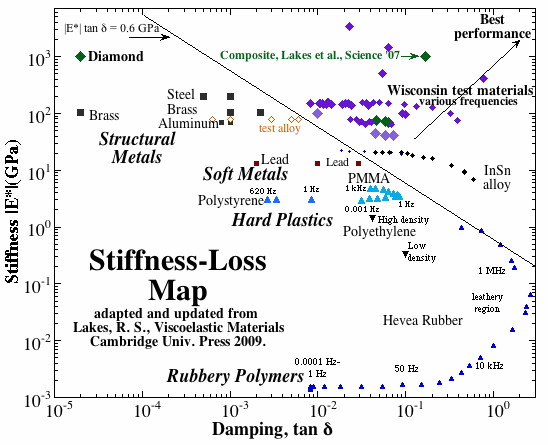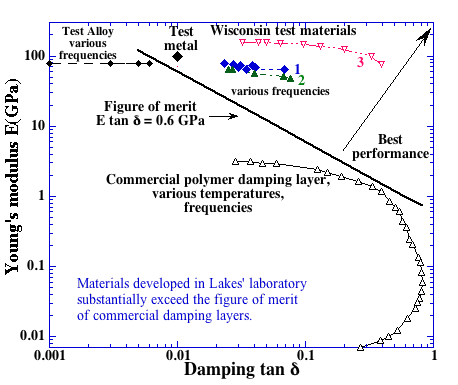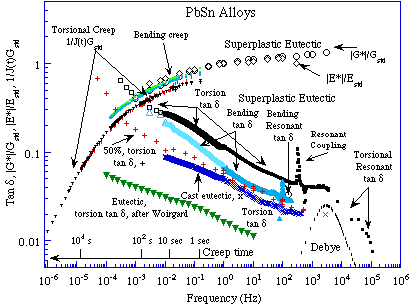
Demonstrations Tutorial Viscoelasticity Books '98 '09 Viscoelasticity Class Biomechanics Ultrasonics Viscoelastic Composites Composites with negative stiffness inclusions Negative Poisson's ratio Piezoelectric materials Industrial research QLV non-QLV

 Lakes, R. S., "Thermoelastic damping in materials with a complex coefficient of thermal expansion. ", J. Mechanical Behav. Mts., 8, 201-216, (1997).
Lakes, R. S., "Thermoelastic damping in materials with a complex coefficient of thermal expansion. ", J. Mechanical Behav. Mts., 8, 201-216, (1997). Damping of superplastic eutectic Pb-Sn is considerably higher than that of cast Pb-Sn, solder wire, and eutectic Pb-Sn reported by Woirgard et al. Viscoelastic damping tan delta approximately follows a power law dependence over about four decades of frequency. The high temperature background is observed over a broad band of frequency at room temperature in this alloy. There was no appeal to time-temperature superposition. The damping in torsion is higher than in bending; the difference is more marked at high frequency. Get pdf
Damping of superplastic eutectic Pb-Sn is considerably higher than that of cast Pb-Sn, solder wire, and eutectic Pb-Sn reported by Woirgard et al. Viscoelastic damping tan delta approximately follows a power law dependence over about four decades of frequency. The high temperature background is observed over a broad band of frequency at room temperature in this alloy. There was no appeal to time-temperature superposition. The damping in torsion is higher than in bending; the difference is more marked at high frequency. Get pdf
 Lee, T., Lakes, R. S., Lal, A. , "Resonant ultrasound spectroscopy for measurement of mechanical damping: comparison with broadband viscoelastic spectroscopy", Rev. Sci. Instr. 71 (7) 2855-2861, July (2000). This article compares resonant ultrasound spectroscopy (RUS) and other resonant methods for the determination of viscoelastic properties such as damping. RUS scans from 50 kHz to 500 kHz were conducted on cubical specimens of several materials including brass, aluminum alloys and PMMA, a glassy viscoelastic polymer. Comparison of damping over the frequency ranges for broadband viscoelastic spectroscopy (BVS) and RUS for indium tin alloy in shear modes of deformation discloses a continuation of the tan delta power-law trend for ultrasonic frequencies up to 300 kHz. For PMMA, resonant peaks were sufficiently broad that higher modes in RUS began to overlap. Viscoelastic damping tan delta via RUS and BVS for PMMA agreed well in the frequency range where the methods overlap. RUS is capable of measuring tan delta as high as several percent at the fundamental frequency. Since higher modes are closely spaced, it is impractical to determine tan delta above 0.01 to 0.02 at frequencies other than the fundamental.
Get pdf
Lee, T., Lakes, R. S., Lal, A. , "Resonant ultrasound spectroscopy for measurement of mechanical damping: comparison with broadband viscoelastic spectroscopy", Rev. Sci. Instr. 71 (7) 2855-2861, July (2000). This article compares resonant ultrasound spectroscopy (RUS) and other resonant methods for the determination of viscoelastic properties such as damping. RUS scans from 50 kHz to 500 kHz were conducted on cubical specimens of several materials including brass, aluminum alloys and PMMA, a glassy viscoelastic polymer. Comparison of damping over the frequency ranges for broadband viscoelastic spectroscopy (BVS) and RUS for indium tin alloy in shear modes of deformation discloses a continuation of the tan delta power-law trend for ultrasonic frequencies up to 300 kHz. For PMMA, resonant peaks were sufficiently broad that higher modes in RUS began to overlap. Viscoelastic damping tan delta via RUS and BVS for PMMA agreed well in the frequency range where the methods overlap. RUS is capable of measuring tan delta as high as several percent at the fundamental frequency. Since higher modes are closely spaced, it is impractical to determine tan delta above 0.01 to 0.02 at frequencies other than the fundamental.
Get pdf